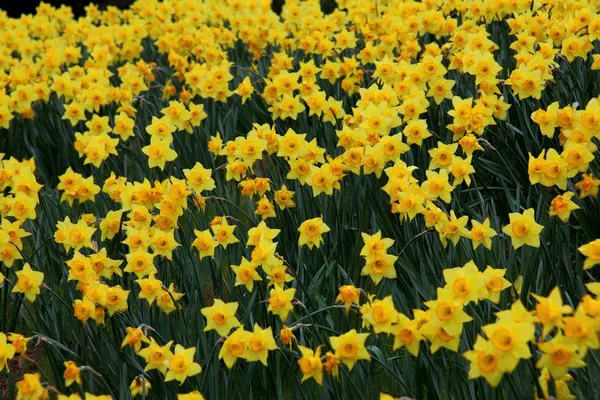Daffodils, with their cheerful blooms and vibrant colors, are among the most beloved flowers in gardens worldwide. Symbolizing rebirth and new beginnings, these harbingers of spring delight gardeners and nature enthusiasts alike. With a myriad of cultivars available, it can be overwhelming to choose the perfect daffodil for your garden. In this comprehensive guide, we delve into the world of daffodils, exploring the most common daffodil varieties, their characteristics, growing requirements, and tips for cultivation.
Daffodils:
Daffodils, scientifically known as Narcissus, belong to the Amaryllidaceae family and are native to Europe and North Africa. They are characterized by their trumpet-shaped central corona surrounded by six petals, giving them their distinct appearance. Daffodils come in a wide range of colors, including yellow, white, orange, and pink, and they bloom in early to late spring, depending on the variety and location.
9 Most Common Daffodil Varieties
1. King Alfred Daffodil (Narcissus ‘King Alfred’):
One of the most iconic daffodil varieties, ‘King Alfred’ features large, bright yellow flowers with a prominent trumpet-shaped corona. This classic cultivar blooms in mid-spring and is known for its reliability and vigor. ‘King Alfred’ daffodils thrive in well-drained soil and full sun to partial shade, making them a popular choice for borders, containers, and naturalizing in lawns.
2. Tête-à-Tête Daffodil (Narcissus ‘Tête-à-Tête’):
Compact and charming, ‘Tête-à-Tête’ daffodils are miniature varieties that produce clusters of golden-yellow flowers with a small trumpet. These early-blooming daffodils are perfect for rock gardens, borders, and containers, adding a pop of color to any spring landscape. ‘Tête-à-Tête’ daffodils prefer well-drained soil and partial shade and are excellent for naturalizing in woodland areas.
3. Ice Follies Daffodil (Narcissus ‘Ice Follies’):
With its delicate white petals and pale yellow trumpet, ‘Ice Follies’ is a graceful and elegant daffodil variety. Blooming in mid to late spring, ‘Ice Follies’ daffodils are prized for their long-lasting flowers and strong, sturdy stems. They thrive in moist, well-drained soil and full sun to partial shade, making them ideal for borders, mass plantings, and cut flower arrangements.
4. Dutch Master Daffodil (Narcissus ‘Dutch Master’):
Robust and reliable, ‘Dutch Master’ daffodils are large-flowered varieties with golden-yellow blooms and a bold trumpet-shaped corona. Blooming in mid-spring, ‘Dutch Master’ daffodils are known for their strong fragrance and long-lasting flowers, making them a favorite among gardeners and florists alike. They prefer well-drained soil and full sun to partial shade and are excellent for naturalizing in meadows and grassy areas.
5. Carlton Daffodil (Narcissus ‘Carlton’):
‘Carlton’ daffodils are mid-season bloomers with large, buttery-yellow flowers and a prominent trumpet-shaped corona. Known for their strong stems and resilience, ‘Carlton’ daffodils are perfect for cutting and are often used in floral arrangements. They prefer moist, well-drained soil and full sun to partial shade and are ideal for borders, rock gardens, and naturalizing in woodland areas.
6. Mount Hood Daffodil (Narcissus ‘Mount Hood’):
Named after the iconic peak in Oregon, ‘Mount Hood’ daffodils are elegant and refined, with creamy-white petals and a pale yellow trumpet. Blooming in mid-spring, ‘Mount Hood’ daffodils are prized for their large flowers and strong, sturdy stems, making them an excellent choice for cut flower arrangements. They prefer well-drained soil and full sun to partial shade and are ideal for borders, rock gardens, and containers.
7. Jetfire Daffodil (Narcissus ‘Jetfire’):
Bold and striking, ‘Jetfire’ daffodils feature bright yellow petals and a contrasting orange-red trumpet, creating a vibrant display in early spring. These miniature varieties are perfect for borders, rock gardens, and containers, adding a splash of color to any landscape. ‘Jetfire’ daffodils prefer well-drained soil and full sun to partial shade and are excellent for naturalizing in grassy areas.
8. Pink Charm Daffodil (Narcissus ‘Pink Charm’):
Unique and enchanting, ‘Pink Charm’ daffodils are a rare variety with delicate pink petals and a small, frilly trumpet. Blooming in mid to late spring, ‘Pink Charm’ daffodils add a touch of elegance to any garden or floral arrangement. They prefer well-drained soil and full sun to partial shade and are ideal for borders, rock gardens, and containers.
9. Golden Ducat Daffodil (Narcissus ‘Golden Ducat’):
With its rich golden-yellow petals and a deep orange trumpet, ‘Golden Ducat’ daffodils are a striking addition to any garden. Blooming in mid-spring, ‘Golden Ducat’ daffodils are known for their vibrant colors and strong, sturdy stems, making them perfect for cut flower arrangements. They prefer well-drained soil and full sun to partial shade and are excellent for naturalizing in grassy areas.
Conclusion:
Daffodils are a delightful addition to any garden, bringing beauty, color, and joy to the landscape. With their wide range of colors, sizes, and bloom times, there is a daffodil variety to suit every taste and garden style. Whether you prefer classic yellow blooms like ‘King Alfred’ or unique varieties like ‘Pink Charm,’ daffodils are sure to brighten your spring and fill your garden with life and vitality. So plant some daffodil bulbs this fall and watch as your garden comes to life with the beauty of these timeless flowers.
You Might Be Interested In:






















